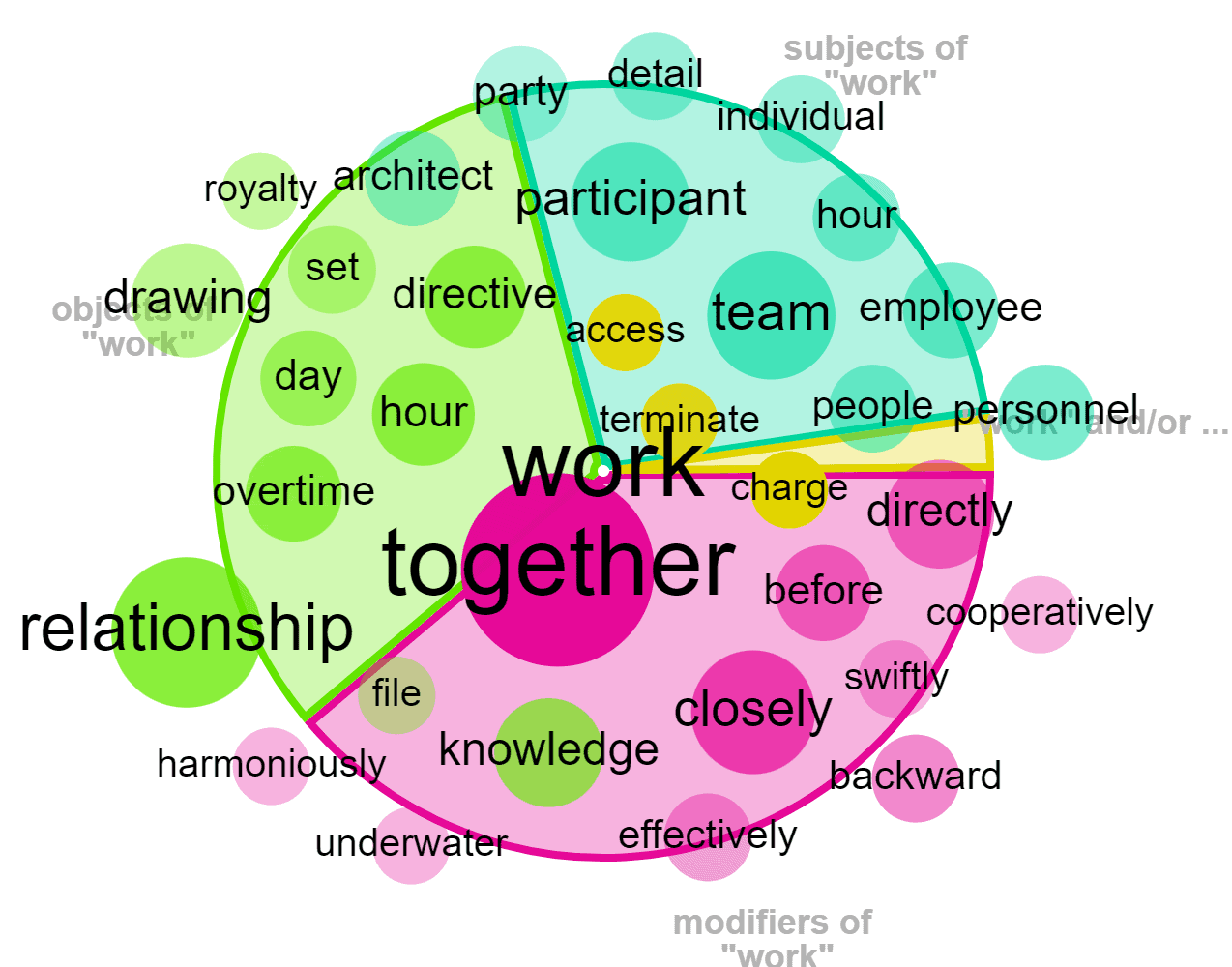Work
Work is a common word, especially in design and construction. However, common words we already know are often used in different ways. These combinations can often mean different things.
Work is both a noun and a verb. This lesson talks about using work as a verb.
Be sure to visit the other lesson that talks about work as a noun.
When used as a verb, work is commonly used with a preposition. WORK AS, for example.
When used with a preposition, it is usually followed by a NOUN or NOUN PHRASE. This use is transitive, which means the verb carries an object. Example: Work on a project (Verb + Preposition + Object)
Here’s a list of the verb phrases in this lesson. Which ones do you know and which ones do you want to learn more about?
WORK FOR
WORK AS
WORK ON
WORK WITH
WORK FROM
WORK THROUGH
WORK TOWARD
WORK INTO
WORK AT
WORK UNDER
WORK OUT
PEOPLE and ORGANIZATIONS
When describing how people or organizations work, here are some useful expressions.
People WORK FOR organizations, clients, or employers.
He works for a client or company

People can WORK AS something. This usually describes the role or job title.
We work as a team.
She works as project manager.

People WORK ON tasks, projects, assignments, etc.
The engineer works on the project.
The architect works on the plans.
People WORK WITH a group or person.
Superintendents work with subcontractors
People WORK WITH a material, system or thing. This describes what they are using to complete their work.
Formwork installers work with site cast concrete.
Engineers work with BIM to avoid conflicts.
People WORK FROM something. This describes a source of information or something they need to refer to.
Contractors must work from the same information.
Framers work from a floor plan to lay out the walls.

People WORK THROUGH a situation or problem. It describes a process.
During the meeting, the team worked through coordination issues.
The design team and contractor worked through their misunderstanding and agreed.

People WORK TOWARD a goal or milestone.
The owner works toward an agreement with the contractor.
The design team is working toward a Friday deadline.

People can WORK (something) INTO a schedule, budget, or other measurable things.
The metal subcontractor worked the changes into their estimate.
The owner worked the appointment into their busy schedule. The keyword here is ‘busy’.

People WORK AT doing something.
This is used when somebody is making great efforts to achieve something or do something well. This is almost always used with the GERUND form of the verb. (V+ing)
Let’s work at improving project communication.
The glass supplier is working at reducing the cost.
The project manager must work at gaining the trust of his team.
People WORK UNDER other people in an organization. This is used to describe one’s role in an organization.
The engineers work under the supervision of the superintendent.
The subcontractors work under the general contractor.

People WORK UNDER difficult conditions or situations. This emphasizes hardship or challenging work conditions.
The project manager was working under extreme pressure from the owner.
The excavation crew worked under difficult weather conditions.

MATERIALS and SYSTEMS
Some expressions describe the properties or performance of something; or whether something is appropriate for use in a specific situation.
Something can WORK OUT.
Something can NOT WORK OUT.
This means the same as ‘resolve.’ Its meaning is a little different, however. We usually say something works out when the end result was not expected, or the process is not 100% easy, smooth or perfect. Note: This is different from the other phrasal verb ‘work out’, meaning exercise.
SYNONYMS
settle, sort out, solve, find a solution to, find an answer to, fix, straighten out, deal with, put right, set right, put to rights, rectify, iron out, reconcile
The decision to change the schedule worked out in the end, but it was very challenging for the team.
The new roofing subcontractor was 2 weeks behind schedule. They did not work out, so the general contractor fired them.
The owner and contractor are working out their problems in the meeting right now.
Something can WORK FOR something.
This means ‘suitable’ or ‘compatible’ or ‘appropriate for’
Rammed earth doesn’t work for commercial buildings.
Stainless steel works perfectly for kitchen projects.
Something can WORK ON something.
This means the same as ‘work for’, except it’s more commonly used for objects or things.
Wood windows don’t work on high-rise buildings.
PVC roofing works well on flat roofs.
Something can WORK WITH something.
This means ‘suitable’ or ‘compatible with’ or ‘appropriate for’
Aluminum bolts don’t work with structural steel.
Asphalt shingles work with pitched roofs.
Other expressions describe a material’s or system’s function or role.
Something can WORK AS something.
This means ‘the same as ‘function as’
Columns work as a structural support.
EPDM works as a water barrier.
Brick veneer works as a rain screen.

PRO TIPS
Take a look at work in the dictionary and study some other uses for the word. Dictionaries work great for learning new word combinations while you’re working towards becoming a better English speaker. Working with dictionaries is very helpful if you can work it into your schedule.
Here’s a link to the word ‘work’ as a verb in the Oxford learner’s dictionary.
If this mini-lesson was helpful, please share with your friends and colleagues. If you’re interested in further study, review the deep dive below.
Until then, I’m going back to work. I have lots to work on… 🙂

LANGUAGE DEEP DIVE
Understanding “Work” as a Verb in Construction English
Multiple Meanings of “Work” in Construction Contexts
The verb “work” carries multiple distinct meanings in construction English, and understanding which meaning applies in each context is essential for clear professional communication. Unlike “work” as a noun—which describes construction activities, deliverables, and scope—”work” as a verb describes actions, functions, problem-solving, and employment relationships.
Construction professionals use “work” as a verb in at least four distinct ways: to describe someone performing labor, to indicate whether equipment or systems function properly, to explain how technical processes operate, and to express problem-solving or collaboration. Each usage appears frequently in project coordination, technical troubleshooting, and construction administration communication.
Work = Perform Labor or Construction Activities
The most common usage of “work” as a verb describes people performing construction activities, labor, or professional services on building projects. This meaning appears constantly in project scheduling, labor coordination, and site management:
“Electricians work on the lighting installation this week.”
“The steel erection crew works from 7 AM to 3:30 PM.”
“Our team works on commercial projects throughout the region.”
This usage connects directly to employment, labor scheduling, and trade coordination. When you say someone “works on” a project, you indicate they are actively performing construction activities or providing professional services.
Common Phrasal Verbs and Collocations:
- Work on: Perform activities related to a specific project, system, or task
“The MEP contractor works on the HVAC installation.” - Work with: Collaborate with other professionals or trades
“Architects work with structural engineers to coordinate steel framing.” - Work for: Be employed by a company or organization
“She works for an international engineering firm.” - Work at: Indicate the location where someone performs their job
“The project manager works at the construction site daily.”
These phrasal verbs appear throughout project coordination, particularly when discussing who performs which activities, when they perform them, and how different trades coordinate their efforts during construction work.
Work = Function or Operate Properly
Construction professionals frequently use “work” to describe whether building systems, equipment, or components function correctly. This usage dominates troubleshooting conversations, commissioning activities, and warranty discussions:
“The HVAC system doesn’t work properly.”
“Check if the fire alarm works before final inspection.”
“The automatic door operators work intermittently.”
When “work” means “function,” it often appears in negative constructions (doesn’t work, won’t work, isn’t working) or questions (does it work? will it work?). This usage is critical during construction commissioning, punch list activities, and post-occupancy troubleshooting.
Related Expressions:
- Get something to work: Make equipment or systems function properly
“Can you get the building automation system to work?” - Make something work: Solve problems to achieve proper function
“The controls contractor made the lighting system work correctly.” - Work properly/correctly: Function as designed or specified
“All fire doors must work properly before substantial completion.”
Understanding this meaning prevents confusion in technical communication. When someone asks “Does the system work?” they’re asking about function, not about whether anyone is physically working on it.
Work = How Something Operates or Functions
Technical explanations often use “work” to describe how systems, processes, or construction methods operate. This usage appears in technical specifications, training materials, operation and maintenance manuals, and explanations of building systems:
“How does the waterproofing system work?”
“The structural system works by transferring loads to the foundation.”
“Expansion joints work by allowing movement in the building structure.”
This meaning focuses on mechanism, process, or technical principles rather than on who performs activities or whether something functions. It answers “how” questions about construction methods, building systems, and technical processes.
Common Patterns in Technical Explanations:
“The [system/component] works by [doing something].”
“Reinforced concrete works by combining concrete’s compressive strength with steel’s tensile strength.”
“This is how [system/process] works.”
“This is how curtain wall installation works: panels attach to structural anchors at each floor level.”
Architects, engineers, and construction managers use this pattern when explaining technical concepts to clients, training construction workers, or documenting building systems for facility management teams.
Work = Problem-Solve or Find Solutions
Construction professionals use “work” to describe collaborative problem-solving, finding solutions to design challenges, or resolving construction issues. This usage emphasizes effort, collaboration, and iterative processes rather than specific activities or functions:
“The design team works through coordination issues between trades.”
“Let’s work together to find a solution for the ceiling height conflict.”
“The contractor and architect are working on the change order pricing.”
Common Phrasal Verbs for Problem-Solving:
- Work through: Solve problems systematically
“The structural engineer works through calculation errors in the beam design.” - Work out: Find solutions or resolve issues
“We need to work out the interface between metal framing and concrete.” - Work around: Find alternative solutions when ideal solutions aren’t possible
“Can we work around the existing utilities without relocating them?” - Work toward: Progress toward a goal or solution
“All consultants work toward meeting the project schedule.”
These phrasal verbs appear constantly in design coordination meetings, RFI responses, and problem-solving discussions where construction teams address conflicts, errors, or unforeseen conditions.
Distinguishing Between “Work” Meanings in Context
The same sentence structure can carry different meanings depending on context. Understanding which meaning applies requires attention to surrounding words and project circumstances:
Example: “The contractor works on the system.”
Meaning 1 (performing activities): “The contractor works on the HVAC system installation.” (physically installing equipment)
Meaning 4 (problem-solving): “The contractor works on the system design coordination issue.” (finding solutions to design conflicts)
Example: “Does it work?”
Meaning 2 (function): “Does the fire suppression system work?” (asking if it operates properly)
Meaning 3 (explanation): “Does the structural system work this way?” (asking if the technical explanation is correct)
Context clarifies meaning. When discussing labor schedules, “work” means performing activities. During commissioning, “work” means function properly. In technical discussions, “work” means operate according to principles. During coordination meetings, “work” often means problem-solving.
Work in Professional Communication Across Disciplines
Architects and Designers:
Architects frequently use “work” when discussing design processes, coordination activities, and how building systems or spatial concepts function:
“We’re working on the building envelope details.” (designing/developing)
“How does the daylighting strategy work?” (explaining technical approach)
“The design team works with the owner to develop the program.” (collaborating)
Engineers:
Engineers use “work” to describe technical functions, structural behavior, and problem-solving during design and construction:
“The lateral system works by distributing seismic loads.” (technical explanation)
“Let’s work through the load calculations together.” (problem-solving)
“The connection detail doesn’t work with the specified beam size.” (technical feasibility)
Construction Managers and Contractors:
Construction professionals primarily use “work” to describe labor activities, schedules, and whether installed systems function properly:
“The masonry crew works Monday through Friday.” (labor schedule)
“We work closely with all subcontractors.” (coordination)
“The temporary lighting doesn’t work on the third floor.” (equipment malfunction)
Common Errors and How to Avoid Them
Confusing “Work” (Verb) with “Work” (Noun):
Non-native English speakers sometimes confuse verb and noun forms, particularly when translating from languages where work-related terms function differently:
Incorrect: “Please to work the electrical system.” (trying to say “install”)
Correct: “Please install the electrical system.” or “Please perform the electrical work.”
Using “Work” When More Specific Verbs Are Better:
While “work” is versatile, construction English often prefers more precise verbs for specific activities:
Generic: “Work the concrete.”
Precise: “Place the concrete.” or “Form the concrete.” or “Finish the concrete.”
Learning construction-specific action verbs helps you communicate more precisely than relying on “work” for all activities.
Further Study and Application
Understanding “work” as a verb—and how it differs from “work” as a noun—is essential for construction professionals communicating in English. The verb appears throughout project coordination, technical troubleshooting, design discussions, and labor management.
To develop fluency, pay attention to how experienced construction professionals use “work” in different contexts. Notice which meaning applies in contract negotiations versus commissioning activities versus design meetings. Practice using phrasal verbs like “work on,” “work out,” and “work through” in your own project communication.
This vocabulary connects to broader construction English patterns. Understanding verb usage supports effective communication about contract management, project coordination, and construction methods. Mastering how “work” functions in professional contexts builds the language skills necessary for successful participation in international construction projects where clear English communication supports project delivery, prevents misunderstandings, and advances careers in the global building industry.




